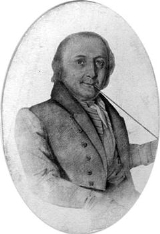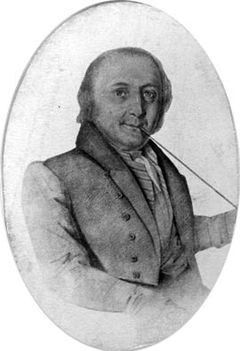
Johann Christian Martin Bartels
Encyclopedia

Germany
Germany , officially the Federal Republic of Germany , is a federal parliamentary republic in Europe. The country consists of 16 states while the capital and largest city is Berlin. Germany covers an area of 357,021 km2 and has a largely temperate seasonal climate...
mathematician
Mathematician
A mathematician is a person whose primary area of study is the field of mathematics. Mathematicians are concerned with quantity, structure, space, and change....
. He was the tutor of Carl Friedrich Gauss
Carl Friedrich Gauss
Johann Carl Friedrich Gauss was a German mathematician and scientist who contributed significantly to many fields, including number theory, statistics, analysis, differential geometry, geodesy, geophysics, electrostatics, astronomy and optics.Sometimes referred to as the Princeps mathematicorum...
in Brunswick
Braunschweig
Braunschweig , is a city of 247,400 people, located in the federal-state of Lower Saxony, Germany. It is located north of the Harz mountains at the farthest navigable point of the Oker river, which connects to the North Sea via the rivers Aller and Weser....
and the educator of Lobachevsky
Nikolai Ivanovich Lobachevsky
Nikolai Ivanovich Lobachevsky was a Russian mathematician and geometer, renowned primarily for his pioneering works on hyperbolic geometry, otherwise known as Lobachevskian geometry...
at the University of Kazan.
Biography
Bartels was born in BrunswickBraunschweig
Braunschweig , is a city of 247,400 people, located in the federal-state of Lower Saxony, Germany. It is located north of the Harz mountains at the farthest navigable point of the Oker river, which connects to the North Sea via the rivers Aller and Weser....
, in the Duchy
Duchy
A duchy is a territory, fief, or domain ruled by a duke or duchess.Some duchies were sovereign in areas that would become unified realms only during the Modern era . In contrast, others were subordinate districts of those kingdoms that unified either partially or completely during the Medieval era...
of Brunswick-Lüneburg
Brunswick-Lüneburg
The Duchy of Brunswick-Lüneburg , or more properly Duchy of Brunswick and Lüneburg, was an historical ducal state from the late Middle Ages until the late Early Modern era within the North-Western domains of the Holy Roman Empire of the German Nation, in what is now northern Germany...
(now part of Lower Saxony
Lower Saxony
Lower Saxony is a German state situated in north-western Germany and is second in area and fourth in population among the sixteen states of Germany...
, Germany
Germany
Germany , officially the Federal Republic of Germany , is a federal parliamentary republic in Europe. The country consists of 16 states while the capital and largest city is Berlin. Germany covers an area of 357,021 km2 and has a largely temperate seasonal climate...
), the son of pewterer
Pewter
Pewter is a malleable metal alloy, traditionally 85–99% tin, with the remainder consisting of copper, antimony, bismuth and lead. Copper and antimony act as hardeners while lead is common in the lower grades of pewter, which have a bluish tint. It has a low melting point, around 170–230 °C ,...
Heinrich Elias Friedrich Bartels and his wife Johanna Christine Margarethe Köhler. In his childhood he showed a great interest in mathematics. In 1783 he was employed as an assistant to the teacher Büttner in the Katherinenschule in Brunswick
Braunschweig
Braunschweig , is a city of 247,400 people, located in the federal-state of Lower Saxony, Germany. It is located north of the Harz mountains at the farthest navigable point of the Oker river, which connects to the North Sea via the rivers Aller and Weser....
. He became acquainted with Carl Friedrich Gauss
Carl Friedrich Gauss
Johann Carl Friedrich Gauss was a German mathematician and scientist who contributed significantly to many fields, including number theory, statistics, analysis, differential geometry, geodesy, geophysics, electrostatics, astronomy and optics.Sometimes referred to as the Princeps mathematicorum...
there and encouraged his talent and recommended him to the Duke of Brunswick who awarded Gauss a fellowship to the Collegium Carolinum (now Technical University of Brunswick
Technische Universität Braunschweig
The TU Braunschweig is the oldest University of Technology in Germany. It was founded in 1745 as Collegium Carolinum and is a member of TU9, an incorporated society of the most renowned and largest German Institutes of Technology. Today it has about 13,000 students, making it the third largest...
). A friendship developed between Gauss and Bartels and they corresponded between 1799 and 1823.
From 23 August 1788 he was a visitor at the Collegium Carolinum in Brunswick.
On 23 October 1791 Bartels studied mathematics under Johann Friedrich Pfaff
Johann Friedrich Pfaff
Johann Friedrich Pfaff was a German mathematician. He was described as one of Germany's most eminent mathematicians during the 19th century...
in Helmstedt
Helmstedt
Helmstedt is a city located at the eastern edge of the German state of Lower Saxony. It is the capital of the District of Helmstedt. Helmstedt has 26,000 inhabitants . In former times the city was also called Helmstädt....
and Abraham Gotthelf Kästner
Abraham Gotthelf Kästner
Abraham Gotthelf Kästner was a German mathematician and epigrammatist.He was known in his professional life for writing textbooks and compiling encyclopedias rather than for original research. Georg Christoph Lichtenberg was one of his doctoral students, and admired the man greatly. He became...
in Göttingen
Göttingen
Göttingen is a university town in Lower Saxony, Germany. It is the capital of the district of Göttingen. The Leine river runs through the town. In 2006 the population was 129,686.-General information:...
. In the winter semester of 1793/1794 he studied Experimental Physics, Astronomy, Meteorology and Geology under Georg Christoph Lichtenberg
Georg Christoph Lichtenberg
Georg Christoph Lichtenberg was a German scientist, satirist and Anglophile. As a scientist, he was the first to hold a professorship explicitly dedicated to experimental physics in Germany...
.
In 1800 he worked in Switzerland
Switzerland
Switzerland name of one of the Swiss cantons. ; ; ; or ), in its full name the Swiss Confederation , is a federal republic consisting of 26 cantons, with Bern as the seat of the federal authorities. The country is situated in Western Europe,Or Central Europe depending on the definition....
as Professor
Professor
A professor is a scholarly teacher; the precise meaning of the term varies by country. Literally, professor derives from Latin as a "person who professes" being usually an expert in arts or sciences; a teacher of high rank...
of Mathematics in Reichenau (Canton
Cantons of Switzerland
The 26 cantons of Switzerland are the member states of the federal state of Switzerland. Each canton was a fully sovereign state with its own borders, army and currency from the Treaty of Westphalia until the establishment of the Swiss federal state in 1848...
Graubünden
Graubünden
Graubünden or Grisons is the largest and easternmost canton of Switzerland. The canton shares borders with the cantons of Ticino, Uri, Glarus and St. Gallen and international borders with Italy, Austria and Liechtenstein...
). In 1801 he was active in the cantonal school in Aarau
Aarau
Aarau is the capital of the northern Swiss canton of Aargau. The city is also the capital of the district of Aarau. It is German-speaking and predominantly Protestant. Aarau is situated on the Swiss plateau, in the valley of the Aar, on the river's right bank, and at the southern foot of the Jura...
. He married Anna Magdalena Saluz from Chur
Chur
Chur or Coire is the capital of the Swiss canton of Graubünden and lies in the northern part of the canton.-History:The name "chur" derives perhaps from the Celtic kora or koria, meaning "tribe", or from the Latin curia....
in 1802. The University of Jena promoted him to the Faculty of Philosophy in 1803.
In 1807 he was invited to join the University of Kasan by the founder Stepan Jakowlewitsch Rumowski (1734–1812), and went there in 1808 were he was appointed to the chair of Mathematics. During his twelve years tenure he lectured on the History of Mathematics, Higher Arithmetic, Differential and Integral Calculus, Analytical Geometry and Trigonometry, Spherical Trigonometry, Analytical Mechanics and Astronomy. During this time he taught Nikolai Ivanovich Lobachevsky
Nikolai Ivanovich Lobachevsky
Nikolai Ivanovich Lobachevsky was a Russian mathematician and geometer, renowned primarily for his pioneering works on hyperbolic geometry, otherwise known as Lobachevskian geometry...
.
In 1821 he moved to the University of Dorpat
University of Tartu
The University of Tartu is a classical university in the city of Tartu, Estonia. University of Tartu is the national university of Estonia; it is the biggest and highest-ranked university in Estonia...
, now Tartu
Tartu
Tartu is the second largest city of Estonia. In contrast to Estonia's political and financial capital Tallinn, Tartu is often considered the intellectual and cultural hub, especially since it is home to Estonia's oldest and most renowned university. Situated 186 km southeast of Tallinn, the...
, Estonia
Estonia
Estonia , officially the Republic of Estonia , is a state in the Baltic region of Northern Europe. It is bordered to the north by the Gulf of Finland, to the west by the Baltic Sea, to the south by Latvia , and to the east by Lake Peipsi and the Russian Federation . Across the Baltic Sea lies...
, where he founded the Centre for Differential geometry. He remained at Dorpat until his death. He was appointed Privy Councillor in 1823. From 1826 he was a corresponding member of the St. Petersburg Academy of Science. He was also awarded high Russian honours. He died in Dorpat.
Family
His daughter, Johanna Henriette Francisca Bartels (1807 – 1867), married Friedrich Georg Wilhelm von StruveFriedrich Georg Wilhelm von Struve
Friedrich Georg Wilhelm von Struve was a Danish-Baltic German astronomer from a famous dynasty.-Life:...
in 1835, after the death of Struve's first wife. She bore Struve six children, the best known of which was Karl de Struve
Karl de Struve
Karl von Struve was a Russian nobleman and politician. He served, in turn, as Russian Envoy Extraordinary and Minister Plenipotentiary to Japan, the United States, and The Netherlands....
(1835 – 1907), who served successively as Russian ambassador to Japan
Japan
Japan is an island nation in East Asia. Located in the Pacific Ocean, it lies to the east of the Sea of Japan, China, North Korea, South Korea and Russia, stretching from the Sea of Okhotsk in the north to the East China Sea and Taiwan in the south...
, the United States
United States
The United States of America is a federal constitutional republic comprising fifty states and a federal district...
, and the Netherlands
Netherlands
The Netherlands is a constituent country of the Kingdom of the Netherlands, located mainly in North-West Europe and with several islands in the Caribbean. Mainland Netherlands borders the North Sea to the north and west, Belgium to the south, and Germany to the east, and shares maritime borders...
.

